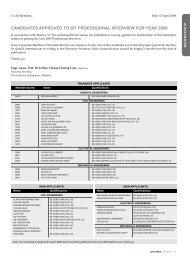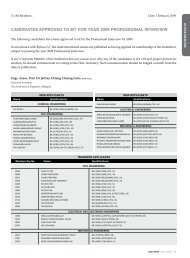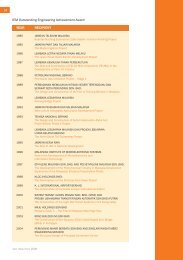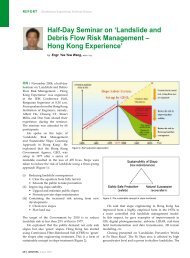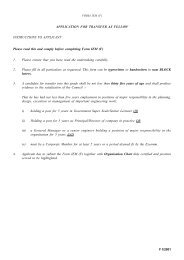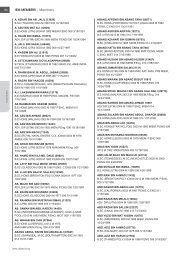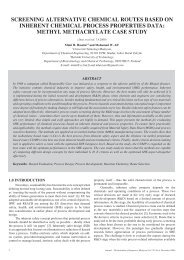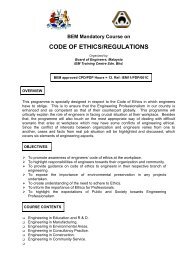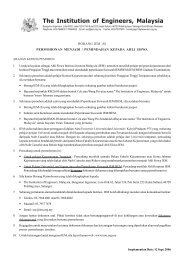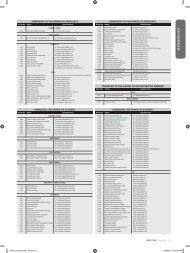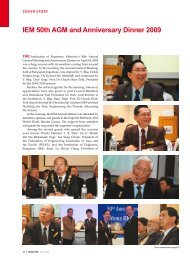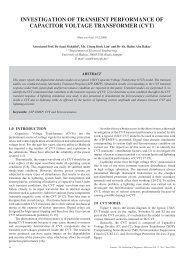Oil and Gas Industry in Malaysia - Institution of Engineers Malaysia
Oil and Gas Industry in Malaysia - Institution of Engineers Malaysia
Oil and Gas Industry in Malaysia - Institution of Engineers Malaysia
You also want an ePaper? Increase the reach of your titles
YUMPU automatically turns print PDFs into web optimized ePapers that Google loves.
REPORT ON TWO DAY CONFERENCE ON<br />
GEOTECHNICAL ENGINEERING THEMED “Design &<br />
Construction <strong>of</strong> Pile Foundation: The <strong>Malaysia</strong>n Experience”<br />
Atwo-day conference on geotechnical<br />
eng<strong>in</strong>eer<strong>in</strong>g themed<br />
“Design & Construction <strong>of</strong> Pile<br />
Foundation: The <strong>Malaysia</strong>n<br />
Experience” was held at Casuar<strong>in</strong>a<br />
Hotel, Ipoh, Perak, on 29-30<br />
September, 2003. The event was<br />
jo<strong>in</strong>tly organised by Jabatan Kerja<br />
Raya <strong>of</strong> Perak, Perak Branch<br />
<strong>and</strong> the Geotechnical Eng<strong>in</strong>eer<strong>in</strong>g<br />
Technical Division <strong>of</strong> The <strong>Institution</strong><br />
<strong>of</strong> Eng<strong>in</strong>eers, <strong>Malaysia</strong>. Over<br />
300 participants from both the<br />
public <strong>and</strong> private sectors attended<br />
the conference.<br />
The conference focused on the<br />
design <strong>and</strong> construction <strong>of</strong> pile<br />
foundations <strong>in</strong> <strong>Malaysia</strong>. The special<br />
lecturers <strong>in</strong>vited to speak <strong>in</strong> the<br />
conference <strong>and</strong> the topics <strong>of</strong> their<br />
presentation are as follows:<br />
Ir. Neoh Cheng Aik<br />
• Pile Foundation Design &<br />
Construction – An Overview<br />
• Site Investigation for Civil<br />
•<br />
Eng<strong>in</strong>eer<strong>in</strong>g Projects<br />
Case Histories <strong>of</strong> Pile Foundation<br />
Design (co-authored with Ir. Sobri<br />
Aziz)<br />
Ir. Yee Yew Weng<br />
• Case Histories <strong>of</strong> Pile Foundation<br />
Failure<br />
Ir. Mun Kwai Peng<br />
• Test<strong>in</strong>g <strong>of</strong> Piles<br />
Reported by: Ir. Tan Yean Ch<strong>in</strong>, Geotechnical Eng<strong>in</strong>eer<strong>in</strong>g Technical Division<br />
Ir. Liew Shaw Shong<br />
• Design <strong>and</strong> Construction <strong>of</strong><br />
Micropiles (co-authored with Mr.<br />
Fong Chew Chung)<br />
Ir. Tan Yean Ch<strong>in</strong><br />
• Design <strong>and</strong> Construction <strong>of</strong> Bored<br />
Pile Foundation (co-authored with<br />
Mr. Chow Chee Meng)<br />
A copy <strong>of</strong> the proceed<strong>in</strong>gs for the<br />
above conference is available <strong>in</strong> the<br />
IEM library for reference.<br />
Participants were given the<br />
opportunity to seek the op<strong>in</strong>ion <strong>of</strong> the<br />
speakers on various topics <strong>of</strong> <strong>in</strong>terest<br />
<strong>in</strong> the last session <strong>of</strong> the conference.<br />
Many aspects <strong>of</strong> pile design <strong>and</strong><br />
construction were raised, rang<strong>in</strong>g<br />
from foundation design to evaluation<br />
<strong>of</strong> performance. Of these, two<br />
topics which attracted considerable<br />
<strong>in</strong>terest were:<br />
1) How do eng<strong>in</strong>eers plan, supervise<br />
<strong>and</strong> ensure that proper subsurface<br />
<strong>in</strong>vestigation (S.I.) is carried out?<br />
2) What criteria should be used<br />
to def<strong>in</strong>e pile failure when<br />
carry<strong>in</strong>g out ma<strong>in</strong>ta<strong>in</strong>ed load test?<br />
For example, should a pile be<br />
considered to have failed <strong>and</strong> the<br />
design deemed to be unacceptable<br />
when it experiences settlement <strong>of</strong><br />
more than 40mm at twice the<br />
design work<strong>in</strong>g load?<br />
A VISIT TO KL MONORAIL SYSTEM<br />
Generally, the panelists strongly<br />
recommended that S.I. should<br />
be properly planned <strong>and</strong> supervised<br />
by the consultant. The Uniform<br />
Build<strong>in</strong>g By-Laws 1984 (Act 133)<br />
stipulates that the consultant<br />
who is responsible for the design<br />
<strong>and</strong> construction <strong>of</strong> the foundation<br />
or structure should also supervise<br />
the field works, which <strong>in</strong>cludes<br />
S.I. This requirement has been<br />
reiterated by the Board <strong>of</strong><br />
Eng<strong>in</strong>eers <strong>Malaysia</strong> (BEM) <strong>in</strong> a recent<br />
circular to all Pr<strong>of</strong>essional Eng<strong>in</strong>eers.<br />
It was recognised that many<br />
specifications state that a test pile is<br />
considered to have failed <strong>and</strong> the<br />
design becomes unacceptable if the<br />
pile settles more than 40mm at twice<br />
the design work<strong>in</strong>g load. However,<br />
from a geotechnical eng<strong>in</strong>eer<strong>in</strong>g<br />
po<strong>in</strong>t <strong>of</strong> view, a pile should only<br />
be considered to have failed if<br />
it exceeds the serviceability limit<br />
for the particular structure for<br />
which the pile was designed to<br />
support. The serviceability limit<br />
will vary depend<strong>in</strong>g on the structure<br />
<strong>and</strong> should be def<strong>in</strong>ed clearly by<br />
the designer. ■<br />
Reported by: Ir. Nah Teik Ong, Highway & Transportation Eng<strong>in</strong>eer<strong>in</strong>g Technical Division<br />
Agroup from IEM consist<strong>in</strong>g <strong>of</strong> 32<br />
members visited the KL<br />
Monorail System (KLMS) on 8 May<br />
2004 at KLMS headquarters <strong>in</strong><br />
Brickfields.<br />
The program for the visit started<br />
by a brief<strong>in</strong>g on the Kuala Lumpur<br />
Monorail System given by Tuan Haji<br />
Ahmad Za<strong>in</strong>udd<strong>in</strong> Jamaludd<strong>in</strong>,<br />
Director <strong>of</strong> KL Monorail System<br />
39<br />
JURUTERA, JANUARY 2005<br />
Sdn. Bhd. The brief<strong>in</strong>g touch on<br />
various aspects <strong>of</strong> the project<br />
<strong>in</strong>clud<strong>in</strong>g the plann<strong>in</strong>g, design,<br />
construction, operation, safety<br />
<strong>and</strong> manufactur<strong>in</strong>g <strong>of</strong> the tra<strong>in</strong>s.<br />
KL Monorail Project<br />
The project cost<strong>in</strong>g about RM1.18<br />
billion is a privatized project implemented<br />
to ease the traffic congestion<br />
REPORT<br />
<strong>in</strong> the city <strong>of</strong> Kuala Lumpur. It is an<br />
<strong>in</strong>tra-city public transport system that<br />
serve the central bus<strong>in</strong>ess, hotel <strong>and</strong><br />
shopp<strong>in</strong>g districts <strong>of</strong> Kuala Lumpur.<br />
The KL Monorail System has started<br />
operation on 31 August 2003.<br />
The alignment <strong>of</strong> the 8.6km long<br />
dual guideway elevated monorail<br />
system beg<strong>in</strong>s from the Jalan Tun<br />
Razak Bus Term<strong>in</strong>al <strong>in</strong> the north <strong>and</strong><br />
passes through Kuala Lumpur’s



